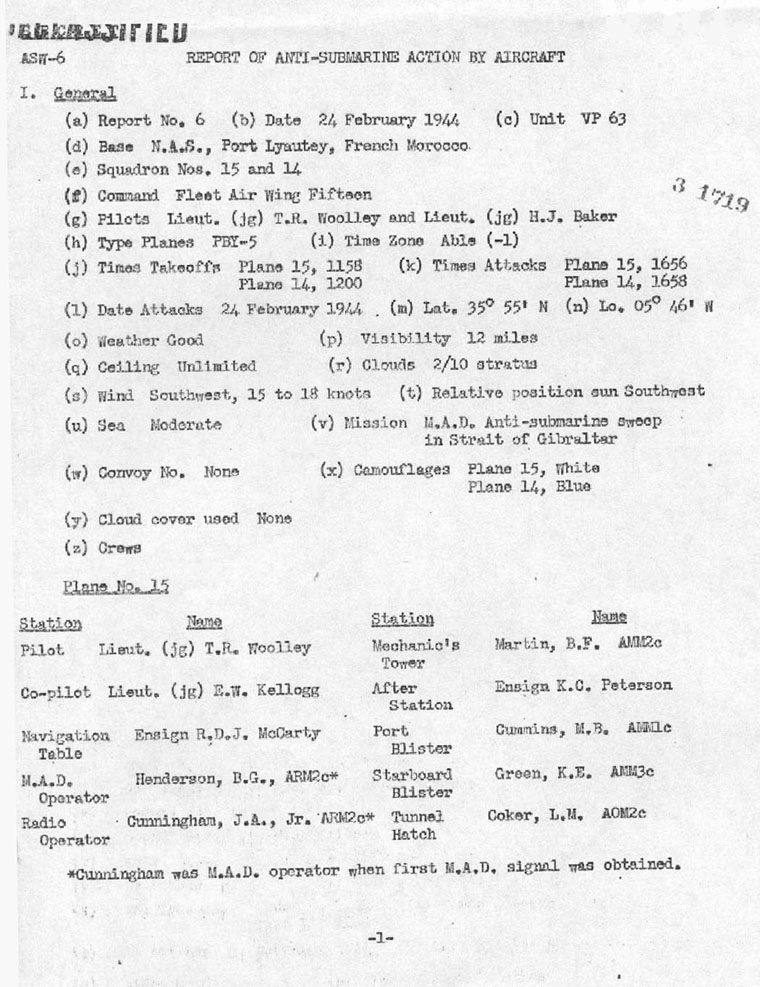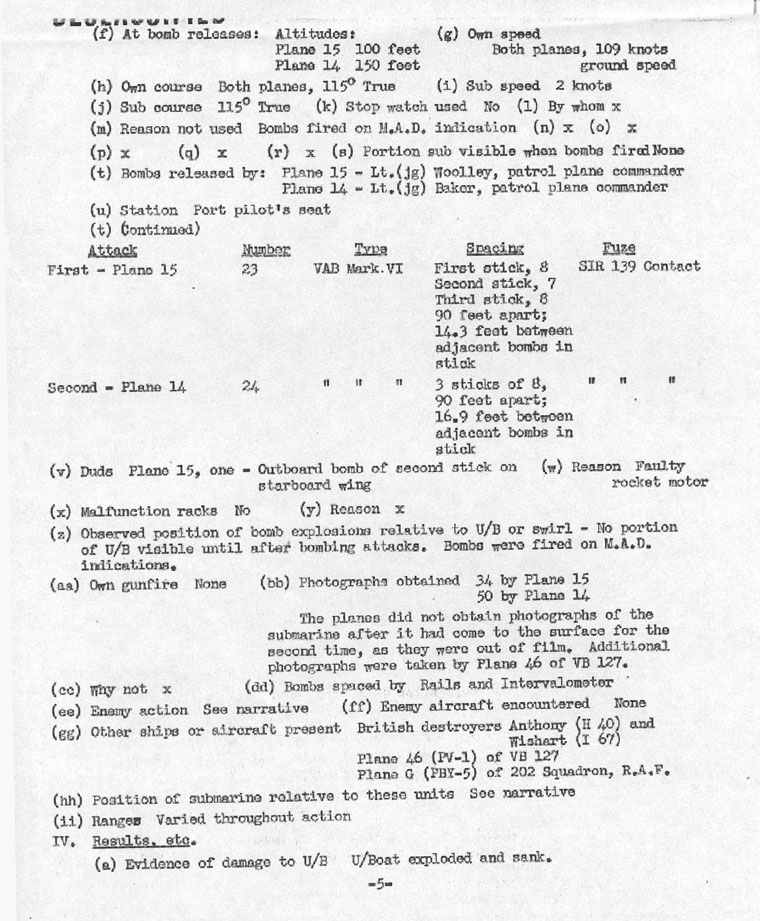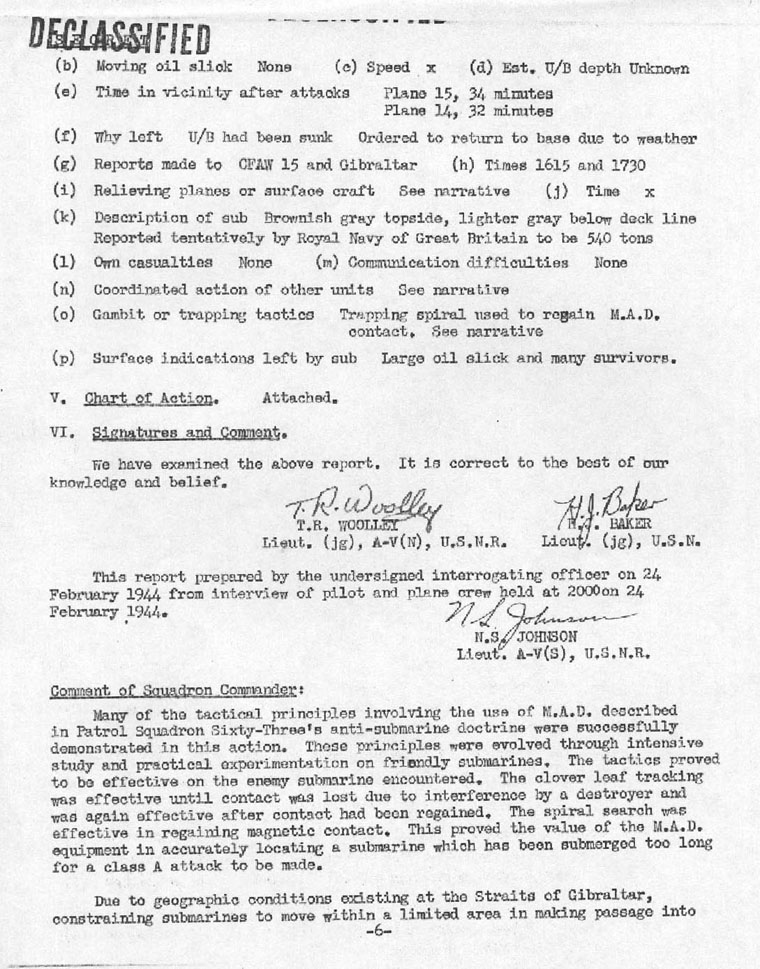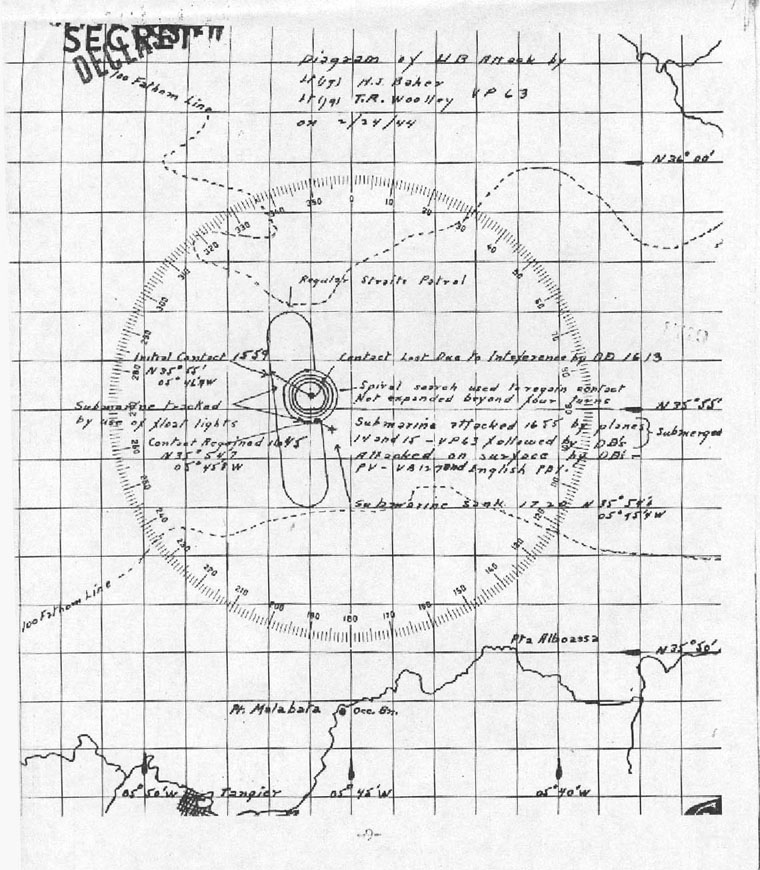

| S E C R E T | ||
| between successive passes over the submerged submarine. Passes over the submarine are made at an altitude of 100 feet, and a Mark V propulsive float light is fired over the submarine on each pass. The float lights accurately mark the track of the submerged target. Bombing runs are not made until the track is fully established and hits are reasonably well assured.) | ||
| After Plane 15 had tracked the submerged submarine for three lights, Plane 14, PBY-5 Bureau No. 08437, joined the tracking, and the planes flew the clover leaf procedure simultaneously, firing float lights on M.A.D. signals. A british destroyer, H.M.S. Anthony (H 40), approached the area from a position two miles west of the point of contact. By the time six float lights were laid, the destroyer was within the clover leaf pattern and offered a serious hazard to the two aircraft, which were flying at 100 feet. On several turns, the destroyer was in the way, and the planes had to break off their tracking passes in order to avoid colliding with the destroyer. Both aircraft requested the destroyer by voice communication to remain in the area but to stay clear of the tracking. | ||
| The destroyer then reported that it had contact and was going to attack. However it headed for the wrong end of the line of float lights. Lieut. (jg) Baker informed it that the target was at the other end. The destroyer promptly turned down the line of lights and scattered them with its wake. Although it passed over the position of the submarine and was clear of the planes and other ships, it did not make an attack. Lieut. (jg) Baker then told the destroyer to stay clear of the area if it was not going to attack. | ||
| Up to this time, the aircraft had succeeded, under difficult conditions of interference, in placing ten float lights on the track of the submerged submarine. After passing over the target, the destroyer announced that it had lost contact. The destroyer left the area at 1622 and steamed off to the west, apparently having lost interest in the contact established by the aircraft. Several fast clover leaf passes were then made over the suspected position of the submarine without success. Lieut. (jg) Baker then directed Lieut. (jg) Woolley to commence a spiral search with instructions not to expand beyond the fourth turn. (The spiral search is essentially a trapping circle which increases in diameter and is flown around the submerged submarine. The objective is to gain magnetic detection as the submarine passes through the circular barrier.) Lieut. (jg) Woolley commenced the spiral search, while Lieut. (jg) Baker made several more clover leaf passes. Being unsuccessful on the clover leaf passes and desiring to insure that the submarine would not escape from the spiral search, Lieut. (jg) Baker joined Lieut. (jg) Woolley at the fourth turn of the spiral, taking a right echelon position. | ||
| At 1645, during the sixth turn in the spiral, Lieut. (jg) Woolley regained magnetic contact about one mile south-southeast of the previous position. Both aircraft conducted tracking procedure. After several float lights had been laid, the British destroyer again headed into the area and continued in its approach despite warnings from the aircraft to remain clear. | ||
- 3 - |
||
| The destroyer, however, headed directly for the end of the line of float lights. Ten float lights had been laid, but both pilots desired to place accurately two or three more lights before making a bombing run. However, considering the possibility that the destroyer would again cause loss of contact, both pilots decided to bomb immediately. | ||
| Lieut. (jg) Woolley announced that he was making a bombing run. The destroyer "rogered" for the message and turned slightly to the left as Plane 15 passed abeam about 300 yards on the bombing run. At 1656 Lieut. (jg) Woolley fired 23 retro-bombs on good magnetic indication, one bomb failing to fire. His altitude was 100 feet, and ground speed 109 knots. | ||
| Lieut. (jg) Baker fired a float light on M.A.D. signal ten seconds after Plane 15 had bombed, then made a 360-degree turn and approached on a bombing run. As he approached, the destroyer was within 100 yards of the end of the line of float lights and appeared to be backing down. Lieut (jg) Baker fired 24 retro-bombs on good M.A.D. indication approximately two minutes after Lieut. (jg) Woolley's attack. The bombing run of Lieut. (jg) Baker was made at an altitude of 150 feet and ground speed of 109 knots. About twenty seconds later, the destroyer Anthony dropped ten depth charges at the position of Lieut. (jg) Baker's bombs. | ||
| At 1702, the conning tower and bow of the U/boat broke surface at the point of attack and directly inline with the string of float lights on the surface. The submarine then lost all way. The stern sank until the bow was the only portion visible, approximately 40 degrees from normal trim. It disappeared stern first at 1703. | ||
| Another British destroyer, H.M.S. Wishart (I 67), had arrived at the scene and attacked with depth charges over the point of submergence. The Anthony followed with another attack of ten depth charges. | ||
| At 1710, the submarine surfaced with no way on, and personnel immediately commenced abandoning ship without manning guns. Both destroyers opened fire on the submarine, and one scored a direct hit on the conning tower. | ||
| At 1717, a U.S. Navy Ventura, Plane 46 of VB-127, Lieut. P.L. Holmes pilot, attacked the submarine with six depth charges. A straddle between the fifth and sixth depth charges was estimated. At 1719, and R.A.F. Catalina, Plane G of 202 Squadron, Flight Lieut. John Finch pilot, made an attack with depth charges and also secured a straddle. | ||
| The bow of the submarine then rose to an angle of about 40 degrees, and at 1720 it sank, leaving many survivors in the water. There was an internal explosion in the submarine just before it sank. The destroyers Anthony and Wishart remained in the area and picked up 48 survivors. One of the survivors died aboard the Anthony. The rest were landed at Gibraltar. | ||
| (b) During approach: Plane darkened No (c) Flares used No | ||
| (d) Searchlight used No | ||
| (e) What recognition signal did U/B make None. U/B was submerged. | ||
- 4 - |
||


| S E C R E T | ||
| Comment of Squadron Commander (Continued) | ||
| the Mediterranean Sea, a plan was evolved to prevent passage of submarines through the Straits by using a two-plane M.A.D. barrier. There is no definite information which indicates that any submarine has ever crossed this barrier. The action described in this report resulted from the M.A.D. contact made on the submerged enemy submarine as it cross the assigned M.A.D. patrol. M.A.D. equipment has proved to be of considerable value as search equipment in confined areas as well as follow-up equipment on surface contacts which submerge before an attack can be made. | ||
| Forty-eight survivors, including the commanding officer of the submarine, were rescued by the destroyers and landed at Gibraltar. Several died from injuries sustained. | ||
| The commanding officers of both the British destroyers reported that explosions of retro-bombs were heard in their underwater listening equipment. It has not yet been established which aircraft of Patrol Squadron Sixty-Three fired the retro-bombs which hit the submerged submarine, due to the short interval between the attacks. The above information, however, assures us that the submarine was hit on a retro-bombing attack, since the bombs would not explode on the bottom unless the bottom were of solid rock or similar hard character. Present charts indicate the bottom at the position of the attack is of a soft nature. | ||
| Preliminary interrogation of the commanding officer of the submarine found him to be greatly perplexed over the attack. He stated that the first explosion caused such damage to his ship aft of the conning tower that it was a case of surfacing "now or never." He was at a loss to understand the extreme accuracy and the devastating effect of these initial explosions. He further stated that he believed the destroyers to be some distance away at the time of the attack which, occurring as it did, took him completely by surprise. | ||
| |
||
| C.H. HUTCHINGS | ||
| Lieutenant Commander, U.S.N. | ||
| Commanding | ||
- 7 - |
||
Note: Pages 8 and 10 (missing) are the MAD records of planes 14 and 15

VP-63 FIRST SUBMERGED M.A.D. CONTACT AND ATTACK |
||
TWO PBY's AIDED BY TWO BRITISH DESTROYERS SINK GERMAN |
||
U-BOAT IN STRAITS OF GIBRALTAR. |
||
| 1558 GCT (Zone -1) 24 February, 1944 35055' N/05046' W | ||
| Two PBY's were flying the Straits of Gibraltar M.A.D. Barrier Patrol at 100 feet altitude over a moderate sea, when plane #15 obtained a M.A.D. contact. Float lights were fired and the pilot immediately commenced the prescribed clover leaf tracking procedure, making 2700 turns between successive passes over the submerged object. | ||
| A Mark V propulsive float light is released by M.A.D. indication on each pass over the contact. The float lights accurately mark the track of the submerged target and bombing runs are not made until the track is definitely established and hits are reasonably well assured. | ||
| After plane #15 had tracked the submarine with three lights, plane #14 joined the tracking and the planes flew the clover leaf procedure simultaneously firing float lights on M.A.D. signals. | ||
| Shortly thereafter a British Destroyer, HMS ANTHONY (H40) approached the area from a position two miles west of the point of contact. By the time six float lights were laid the destroyer was within the clover leaf pattern and offered a serious hazard to the two aircraft which were flying at 100 feet attempting to continue the tracking. On several turns the destroyer was in the way and the planes had to break off their passes in order to avoid collision with the masts of the ships. Both aircraft requested the destroyer by voice communication to remain in the area but to stay clear of the tracking. | ||
| The destroyer soon reported that she had made contact and was going to attack, but then headed for the wrong end of the float lights. The pilot of plane #14 informed the destroyer that the target was at the other end of the lights so the destroyer promptly reversed course and passed down the line of lights. After passing over the target without | ||
| attacking, the destroyer announced that it had lost contact. The pilot of plane #14 then requested the destroyer to stay clear of the area. The destroyer steamed off to the west, clear of the area. | ||
| To regain contact the planes began a series of fast clover leaf passes over the supposed position, but without success. Plane #14 then directed plane #15 to commence a spiral search but not to expand the diameter beyond the fourth turn. (The spiral search is essentially a trapping circle, which increases in diameter as it is flown around the presumed position of the submarine. The objective is to gain magnetic detection as the submarine passes through the circular barrier). While plane #15 was engaged in this spiral search, plane #14 made several more cloverleaf passes without success and then joined plane #15 on the fourth turn of the spiral, taking a right echelon position. | ||
| About twenty minutes later, during the sixth turn in the spiral, plane #15 regained magnetic contact about one mile to the southeast of the previous position. Both aircraft then commenced the regular tracking procedure. After dropping several float lights, they observed the British destroyer again heading into the area despite repeated warnings from the aircraft to stay clear. The destroyer headed directly for the end of the float lights, and although the pilots desired to place two or three more float lights before making a bombing run, they decided not to delay the attack further less the contact be lost again. | ||
| Plane #15 started a bombing run, informing the destroyer which turned slightly to port to clear the area. 23 sixty-five pound VAB contact bombs were retro-fired on good magnetic indication from an altitude of 100 feet at a ground speed of 109 knots. The bombs were dropped in three sticks, eight bombs to the first and third sticks, and seven bombs to the second. The sticks were spaced 90 feet apart with 14.3 feet between the | ||
| adjacent bombs in each stick. Explosions from the bombs were noticed, indicating that they found their target. | ||
| Ten seconds after plane #15 had attacked, plane #14 fired another float light on a M.A.D. signal and then made a 3600 turn and approached on a bombing run. The destroyer by this time was within 100 yards of the end of the line of float lights. 25 sixty-five pound retro-bombs were fired on a good M.A.D. indication approximately two minutes after plane #15's attack. These bombs were dropped in three sticks of eight each with ninety feet between the sticks and 16.9 between the adjacent bombs of each stick. The attack was made from and altitude of 150 feet and a ground speed of 109 knots. Some of the bombs were seen to explode. | ||
| About twenty seconds after plane #14 had completed its run the destroyer dropped ten depth charges at the position of the explosions of the bombs dropped from plane #14. | ||
| About five minutes later the conning tower and the bow of the U-boat broke the surface at the point of attack and directly in line with the float lights which had been dropped marking its submerged track. The submarine lost all forward way and the stern settled quickly until the bow was only partly visible at an angle of about 400. It disappeared stern first one minute later. | ||
| In the meantime another British Destroyer, HMS WISHART (I 67) had arrived on the scene and now attacked with depth charges over the point where the submarine was seen to settle stern first. The ANTHONY quickly followed this attack, dropping ten more depth charges almost immediately. | ||
| About five or six minutes later the submarine surfaced and personnel immediately commenced abandoning ship without manning the guns. Both destroyers opened fire on the submarine and one direct hit was scored on the conning tower. | ||
| Seven minutes later a PV of VB 127 attacked the submarine with six depth bombs obtaining a straddle between the fifth and sixth bombs and two minutes after this an RAF Catalina dropped more depth bombs, also securing a straddle. | ||
| The bow of the submarine then rose to an angle of about 40 and sank. Twenty-five minutes had elapsed since the first retro-bombing attack by VP63. The destroyer then began picking up the survivors, 48 of whom were rescued. | ||
| COMMENT: In as much as this attack is being assessed by the Admiralty, this resume is presented only as a matter of interest to all units concerned with M.A.D. and its applied tactics. | ||
| The M.A.D. tactics used by the two planes in this attack were properly and intelligently employed. By tracking and attacking as per doctrine, the planes definitely aided in the completion of a successful coordinated attack. | ||
| The report on this action was well prepared. The photographs obtained were quite valuable although they would have been easier to follow had a description of each photograph been included. | ||